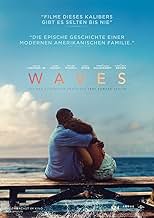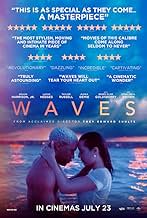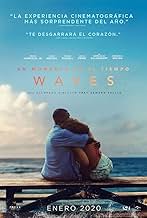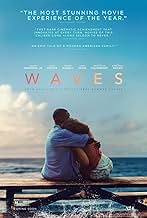El viaje de una familia mientras navegan por el amor, el perdón y la unión después de una pérdida.El viaje de una familia mientras navegan por el amor, el perdón y la unión después de una pérdida.El viaje de una familia mientras navegan por el amor, el perdón y la unión después de una pérdida.
- Dirección
- Guionista
- Elenco
- Premios
- 14 premios ganados y 40 nominaciones en total
Ruben E. A. Brown
- Wally
- (as Ruben E.A. Brown)
David A Payton
- Security Guard
- (as David Anthony Payton)
- Dirección
- Guionista
- Todo el elenco y el equipo
- Producción, taquilla y más en IMDbPro
Opiniones destacadas
High school senior Tyler Williams is on top of the world. His family is supportive and well off. He has his friends and a beautiful girlfriend. He's a star wrestler at school. His father (Sterling K. Brown) pushes hard but he does it out of concern. A nagging injury turns out to be more. A series of self-inflicted problems and unforeseen difficulties come at him in waves.
I like this movie as soon as it starts. It begins with a great cinematic vision. Then it turns into a compelling character study of a family. I am a little conflicted about the divide in the movie. It would have been perfectly great to wrap up the movie soon after the midway point. I do see the value of the change over but it does split the movie in two. Also, it gets a little long at over two hours. It may be worthwhile to give the sister more screen time in the first half. Overall, it's a compelling study of this family.
I like this movie as soon as it starts. It begins with a great cinematic vision. Then it turns into a compelling character study of a family. I am a little conflicted about the divide in the movie. It would have been perfectly great to wrap up the movie soon after the midway point. I do see the value of the change over but it does split the movie in two. Also, it gets a little long at over two hours. It may be worthwhile to give the sister more screen time in the first half. Overall, it's a compelling study of this family.
Writer/director Trey Edward Shults's previous films, the unconventional Thanksgiving drama Krisha (2015) and the brilliant but poorly marketed post-apocalyptic thriller Viene de noche (2017) would seem to have little in common with the more social realist concerns of Waves. However, all three share the same thematic DNA, focusing as they do on a family under intense pressure. And as with those films, if you're into formalism, you'll find plenty here to keep you happy; elaborate camera moves, varying aspect ratios, unusual colour correction, striking shot composition, a sound design which bleeds into the soundtrack/score (and vice versa), a quite audacious shift in focalisation at the half-way point, and a stunningly concise closing shot. On the other hand, it's emotionally bruising and takes its sweet time getting anywhere. It also asks much more of the viewer than your average Marvel movie, and some simply won't want to put in the legwork. Nothing wrong with that, of course, but if you consider cinema as entertainment only, I'd imagine Waves will leave you bored and frustrated. However, if you have the patience and are willing to take the journey on which the film wants to bring you, the cathartic rewards are many.
In a middle-class suburb in Florida, Tyler Williams (a brilliant Kelvin Harrison Jr.) is a popular high school senior and skilled wrestler, who is deeply in love with his girlfriend Alexis Lopez (Alexa Demie). At home, he has a good relationship with his sister Emily (a heartbreakingly sweet Taylor Russell) and stepmother Catherine (Renée Elise Goldsberry). However, his relationship with his domineering father Ronald (a sternly intimidating Sterling K. Brown in full-on stare mode) is somewhat strained due to Ronald, himself a former athlete who was forced to retire due to a knee injury, constantly pushing him to succeed. As the film begins, Tyler's shoulder is causing him problems, and although he keeps it a secret, he soon learns he has a Level 5 SLAP tear, with his doctor telling him he'll need surgery and a few months off from wrestling, or the damage will become permanent. However, he ignores the doctor's advice, continuing to wrestle and starting to self-medicate with Ronald's painkillers. Meanwhile, he becomes increasingly acerbic and starts drinking heavily. At around the half-way point of the film, the focalisation then shifts to the shy and socially awkward Emily, looking at her burgeoning romance with Tyler's wrestling teammate Luke (a passive and pensive Lucas Hedges). Meanwhile, the Williams family must try to come to terms with a horrific act of violence that could change all of their lives.
The most noticeable thing about Waves is the aesthetic audaciousness. What's especially interesting about the narrative bifurcation is that Emily barely appears in the first half and Tyler barely appears in the second, forcing the audience to completely recalibrate themselves vis-à-vis the film's milieu. However, for all its narrative gymnastics, it's Waves's visuals that really pop. Working with his regular cinematographer Drew Daniels, no matter how elaborate Shults's use of form becomes, it's always in service of the story, with the camera being used thematically rather than as a passive tool of observation. For example, the opening shot is inside a car occupied by Tyler and Alexis, but rather than shoot the scene in a shot/counter-shot format, Shults positions the camera between the duo, spinning in circles, and completing multiple 360-degree rotations. This immediately inculcates us into their sense of abandonment and exuberance. Before a single line of dialogue has been spoken, Shults has already started telling us who these people are. It's pure visual storytelling, showing rather telling.
This kind of form/content correlation occurs throughout the film. For example, in the first half, which is focalised by the restless and propulsive Tyler, the handheld camera rarely stops moving, reflecting his frenetic energy. However, when we shift to the quieter and more withdrawn Emily, Shults uses more static tripod shots and a much slower editing rhythm, which reflects Emily's calmer disposition. He also has the palette reflect this shift - whereas the first half is awash in garish blues, reds, and greens, the second has a more naturalistic look. A crucial part of the film's visual identity is the very unusual use of aspect ratio(s). Beginning in 1.85:1, the frame gradually reduces in width until it gets to 1.33:1, which is how Tyler's section ends. Then, at the start of Emily's section, it starts to widen again, eventually reaching 2.35:1. The narrowing ratio of the first half reflects how Tyler feels he's being progressively trapped as things continue to go wrong, whilst the widening ratio of the second half reflects Emily's determination to recover from tragedy and reconcile her family. In short, the first half symbolises an ever-increasing restriction, the second half a gradually discovered freedom.
And all of this is to say nothing of the diegetic lighting, the shot compositions and camera blocking, or the blending of Johnnie Burn's immersive sound design, Trent Reznor and Atticus Ross's discordant score, and the exceptional 32-song soundtrack.
Thematically, the film looks at the pressure to succeed, particularly in men. Ronald equates masculinity with strength, mocks Catherine's job, and barely acknowledges Emily. Instead, he pours all his effort into Tyler, through whom he's trying to live vicariously, pushing him to be the successful athlete that he himself could have been before injury ended his career. He's also acutely aware that as an African-American man, things won't come easy to his son, telling Tyler, "we are not afforded the luxury of being average." However, Ronald is by no means the villain of the piece. He seems to genuinely feel that raising Tyler in this manner is the best thing, telling him, "I don't push you because I want to, I push you because I have to". The problem with all of this is that neither Tyler nor Ronald have a backup plan, so when things start to go wrong, Tyler immediately falls apart. And as things get worse and worse, he becomes a pseudo-Job figure, with the big difference being that Job was self-aware and understood his suffering.
In terms of problems, there are a few blatantly expositionary scenes. An especially egregious example is the scene where Ronald outlines how hard it is for a black man to get ahead in the US, using that as justification for why he pushes Tyler so hard. Whilst the sentiments are fine, it doesn't ring true that this is the first time Ronald has said this to Tyler. Surely he would have given him this talk in his youth? It's a well-acted scene in isolation, but in the context of the overall script, it's too literal and seems out of place. Additionally, Shults tends to use the stuff of daytime soap to propel the plot - the end of a sports career, the prospect of having a child at such a young age, a family tragedy. The performers make the material work, but the film does come close to melodrama on occasion.
Nevertheless, although it's initially bleak, looking at loss and disintegration, Waves ultimately reveals itself to be about the ability of love to conquer despair, about how life can persist no matter the circumstances, about the importance and restorative power of family. Shults uses this framework to build a quite audacious monument that celebrates the ordinary without ever overshadowing it.
In a middle-class suburb in Florida, Tyler Williams (a brilliant Kelvin Harrison Jr.) is a popular high school senior and skilled wrestler, who is deeply in love with his girlfriend Alexis Lopez (Alexa Demie). At home, he has a good relationship with his sister Emily (a heartbreakingly sweet Taylor Russell) and stepmother Catherine (Renée Elise Goldsberry). However, his relationship with his domineering father Ronald (a sternly intimidating Sterling K. Brown in full-on stare mode) is somewhat strained due to Ronald, himself a former athlete who was forced to retire due to a knee injury, constantly pushing him to succeed. As the film begins, Tyler's shoulder is causing him problems, and although he keeps it a secret, he soon learns he has a Level 5 SLAP tear, with his doctor telling him he'll need surgery and a few months off from wrestling, or the damage will become permanent. However, he ignores the doctor's advice, continuing to wrestle and starting to self-medicate with Ronald's painkillers. Meanwhile, he becomes increasingly acerbic and starts drinking heavily. At around the half-way point of the film, the focalisation then shifts to the shy and socially awkward Emily, looking at her burgeoning romance with Tyler's wrestling teammate Luke (a passive and pensive Lucas Hedges). Meanwhile, the Williams family must try to come to terms with a horrific act of violence that could change all of their lives.
The most noticeable thing about Waves is the aesthetic audaciousness. What's especially interesting about the narrative bifurcation is that Emily barely appears in the first half and Tyler barely appears in the second, forcing the audience to completely recalibrate themselves vis-à-vis the film's milieu. However, for all its narrative gymnastics, it's Waves's visuals that really pop. Working with his regular cinematographer Drew Daniels, no matter how elaborate Shults's use of form becomes, it's always in service of the story, with the camera being used thematically rather than as a passive tool of observation. For example, the opening shot is inside a car occupied by Tyler and Alexis, but rather than shoot the scene in a shot/counter-shot format, Shults positions the camera between the duo, spinning in circles, and completing multiple 360-degree rotations. This immediately inculcates us into their sense of abandonment and exuberance. Before a single line of dialogue has been spoken, Shults has already started telling us who these people are. It's pure visual storytelling, showing rather telling.
This kind of form/content correlation occurs throughout the film. For example, in the first half, which is focalised by the restless and propulsive Tyler, the handheld camera rarely stops moving, reflecting his frenetic energy. However, when we shift to the quieter and more withdrawn Emily, Shults uses more static tripod shots and a much slower editing rhythm, which reflects Emily's calmer disposition. He also has the palette reflect this shift - whereas the first half is awash in garish blues, reds, and greens, the second has a more naturalistic look. A crucial part of the film's visual identity is the very unusual use of aspect ratio(s). Beginning in 1.85:1, the frame gradually reduces in width until it gets to 1.33:1, which is how Tyler's section ends. Then, at the start of Emily's section, it starts to widen again, eventually reaching 2.35:1. The narrowing ratio of the first half reflects how Tyler feels he's being progressively trapped as things continue to go wrong, whilst the widening ratio of the second half reflects Emily's determination to recover from tragedy and reconcile her family. In short, the first half symbolises an ever-increasing restriction, the second half a gradually discovered freedom.
And all of this is to say nothing of the diegetic lighting, the shot compositions and camera blocking, or the blending of Johnnie Burn's immersive sound design, Trent Reznor and Atticus Ross's discordant score, and the exceptional 32-song soundtrack.
Thematically, the film looks at the pressure to succeed, particularly in men. Ronald equates masculinity with strength, mocks Catherine's job, and barely acknowledges Emily. Instead, he pours all his effort into Tyler, through whom he's trying to live vicariously, pushing him to be the successful athlete that he himself could have been before injury ended his career. He's also acutely aware that as an African-American man, things won't come easy to his son, telling Tyler, "we are not afforded the luxury of being average." However, Ronald is by no means the villain of the piece. He seems to genuinely feel that raising Tyler in this manner is the best thing, telling him, "I don't push you because I want to, I push you because I have to". The problem with all of this is that neither Tyler nor Ronald have a backup plan, so when things start to go wrong, Tyler immediately falls apart. And as things get worse and worse, he becomes a pseudo-Job figure, with the big difference being that Job was self-aware and understood his suffering.
In terms of problems, there are a few blatantly expositionary scenes. An especially egregious example is the scene where Ronald outlines how hard it is for a black man to get ahead in the US, using that as justification for why he pushes Tyler so hard. Whilst the sentiments are fine, it doesn't ring true that this is the first time Ronald has said this to Tyler. Surely he would have given him this talk in his youth? It's a well-acted scene in isolation, but in the context of the overall script, it's too literal and seems out of place. Additionally, Shults tends to use the stuff of daytime soap to propel the plot - the end of a sports career, the prospect of having a child at such a young age, a family tragedy. The performers make the material work, but the film does come close to melodrama on occasion.
Nevertheless, although it's initially bleak, looking at loss and disintegration, Waves ultimately reveals itself to be about the ability of love to conquer despair, about how life can persist no matter the circumstances, about the importance and restorative power of family. Shults uses this framework to build a quite audacious monument that celebrates the ordinary without ever overshadowing it.
This treasure of a film explores the emotions, circumstance and consequence after a moment of chaos, that moment when in an instant the world begins to crumble and the lives and directions of so many are instantly and irredeemably altered. An original story, beautifully shot, elegantly performed and imaginatively directed. Left me asking the question: are any of us as bad as our worst fifteen minutes?
There's some exquisite lighting effects in "Waves," from a crackling fire to police light bars and rainbows, which is complimented by occasionally kinetic montage and hand-held camera movement. Quite a few shots tracking behind figures' heads in this one. And all of the bobbing of the frame coalesces with the rhythm of the soundtrack. The narrative is something of a rigmarole, though. Following the oscillations of a suburban African-American family in crisis, from teenage son wrestler abusing painkillers for his injured shoulder while fighting with his girlfriend over pregnancy, to the daughter dating one of her brother's teammates, I guess, while the father and mother struggle with their relationship and business. The melodramatic climax actually occurs in the middle of the picture, and it's intense. Even the aspect ratio closes in from the usual rectangle to more of a square tending to frame the characters' faces.
Yet, tracking the immature emotional waves of teenagers for over two hours, in what is essentially two pictures in one with two separate protagonists, is exhausting. Nary any intellectual engagement is to be had. The score is all over the place and generally prominent. Maybe you'll like the music and maybe you won't, or perhaps you'll be like me and like some it and not the rest. The problem, however, is that the picture relies too heavily upon it. Teens, their music and feelings. Lots of scenes merely of figures riding around in cars. Drama frequently trying to be wrought from texting and social media. When the tortuous theatrics are, at last, wrapped up, it comes as a relief.
Yet, tracking the immature emotional waves of teenagers for over two hours, in what is essentially two pictures in one with two separate protagonists, is exhausting. Nary any intellectual engagement is to be had. The score is all over the place and generally prominent. Maybe you'll like the music and maybe you won't, or perhaps you'll be like me and like some it and not the rest. The problem, however, is that the picture relies too heavily upon it. Teens, their music and feelings. Lots of scenes merely of figures riding around in cars. Drama frequently trying to be wrought from texting and social media. When the tortuous theatrics are, at last, wrapped up, it comes as a relief.
I found the first part of the movie really captivating, intense, credible and very well acted. When the focus switches to the second teen in the families the whole plot becomes very mellow (still very well acted though but diminishing the overall impact).
¿Sabías que…?
- TriviaThe script Trey Edward Shults sent to Sterling K. Brown was a PDF with embedded music cues, varying font sizes and colors, and notes about aspect ratio changes.
- ErroresWhen Ronald is with his daughter Emily by the lake fishing, there is a sound of a plane overhead and Emily looks up at the sky through a gap in the tree canopy's and there's a plane in the sky, the problem is it is moving too slowly in relation to its size suggesting it is closer to the ground and therefore should be seen to be moving a little quicker. They obviously used CGI but should have got a better handle on this perspective .
- ConexionesFeatured in CTV News at 11:30 Toronto: Episode dated 10 September 2019 (2019)
- Bandas sonorasFloriDada
Written by Panda Bear (as Noah Lennox), Avey Tare (as David Portner), Geologist (as Brian Weitz)
Performed by Animal Collective
Published by Domino Publishing Company USA (ASCAP)
Courtesy of Domino Recording Company
Selecciones populares
Inicia sesión para calificar y agrega a la lista de videos para obtener recomendaciones personalizadas
Detalles
Taquilla
- Presupuesto
- USD 6,000,000 (estimado)
- Total en EE. UU. y Canadá
- USD 1,658,790
- Fin de semana de estreno en EE. UU. y Canadá
- USD 134,333
- 17 nov 2019
- Total a nivel mundial
- USD 2,576,990
- Tiempo de ejecución2 horas 15 minutos
- Color
- Mezcla de sonido
- Relación de aspecto
- 1.33 : 1
- 1.85 : 1
- 2.66 : 1
Contribuir a esta página
Sugiere una edición o agrega el contenido que falta











































